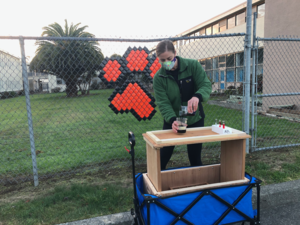
Team Sailor Noobs created a Mobile Science Station for Six Rivers Charter School so that science instructor Bethany Schmidt may safely and easily transport lab equipment to and from the classroom in order to be able to host class outside. Throughout the design process there has been careful consideration of making the design replicable so that the stations may be manufactured for the school for as many classes that need it.
Background[edit | edit source]
Team Sailor Noobs is an intrepid band of engineers at Cal Poly Humboldt comprised of, Tricia Bender, Claire Indvoldsen, and Marty King. Team Sailor Noobs was established in ENGR 215 Intro to Design in September 2020 during the Fall Semester per Lonny Grafman’s instruction. Team Sailor Noobs goal is to ameliorate the unsafe conditions that Six Rivers Charter High School in Arcata, California is facing due to COVID 19 during their reopening for in person or hybrid instruction. While this is a multi-faceted problem, Team Sailor Noobs is specifically tasked with creating an environment in which the students may complete their outdoor science labs safely and without disrupting Six Rivers Charter High Schools’ curriculum in a way that holds true to Six Rivers’ culture and ethos.
Problem statement and criteria[edit | edit source]
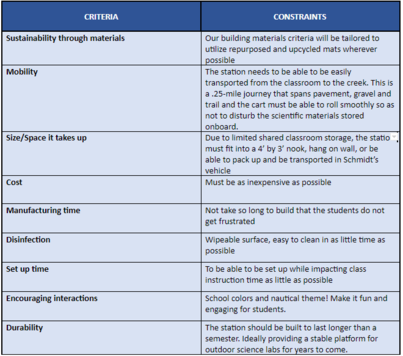
Specifications for building an outdoor science lab station that meets the needs for Bethany Schmidt’s science class at Six Rivers Charter High School:
- Must be mobile, able to make repeated journeys from the classroom to the creek
- Needs to provide safe storage space for the lab materials being transported while keeping jostling at a minimum and guarding against breaks and spills.
- Has to be able to fit into the limited shared storage space within Bethany Schmidt’s classroom
Description of final project[edit | edit source]
The final product is a Ozark Trail collapsible cart with a fitted removable storage made of upcycled wood. The storage lid doubles as a table top with sliding legs to be used as a demonstration workspace. Inside of the wooden storage there is a second storage area that is removable and adjustable to safely hold glassware for transportation. Include a how to use and maintain section. See the how to template below.
Prototyping[edit | edit source]
TSN spent 5 hours generating three prototypes to formulate and test how to best fulfill the specified criteria.
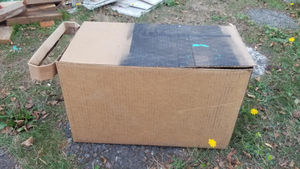

The first prototype was useful because it led TSN to understand that a full size cart would be too large, but the final product include custom adjustable storage for glassware.
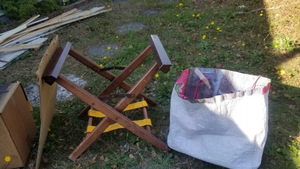
Costs[edit | edit source]
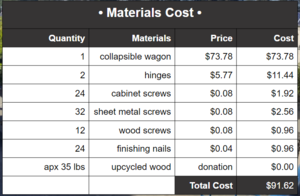
How To Build It[edit | edit source]
How To Use It[edit | edit source]
Testing Results[edit | edit source]
The feedback from the client from the initial prototyping phase informed which design elements were most beneficial and more successful. The first prototype led to the removable storage, the second and third led to TSN purchasing a pre-made collapsible cart in order to minimize cost and decrease replicability. The store bought cart is the most expensive component but designing and building a new version would not be cost beneficial, monetarily or in terms of time management. Assembly instructions can be modified to fit any collapsible utility wagon and thus, classrooms everywhere should be able to build one of their own.
Maintenance[edit | edit source]
This design does not require much in the way of maintenance. Few day to day tasks, and yearly preventative maintenance as needed.
Schedule[edit | edit source]
This is when to maintain what.
- Daily
- Wipe down and sanitize
- Clean tires of mud & debris
- Adjust glassware storage if needed
- Yearly
- Check wheels/casters, replace if needed
- Oil hinges and wood
Discussion and next steps[edit | edit source]
Team Sailor Noob plans on installing 6 sets of screw threads so that ring stands may be mounted at client's discretion. The team also needs to procure a nylon jolly roger flag to sew onto the cart in order to cover the manufacturers label as well as dually promote the school mascot as well as serve as a warning to all who encounter the Mobile Science Station that, "Thar be science here..." (12/11/20 - 12/13/20)
Suggestions for future changes[edit | edit source]
TSN can design an array of storage options that are customizable to fit an array of needs for different subject areas so that other teachers and classes may easily transport their supplies outside in order to hold outdoor classes.
References[edit | edit source]
Link to design document on Google Drive
TEAM SAILOR NOOBS is Tricia bender, Claire ingvoldsen, and Marty king










